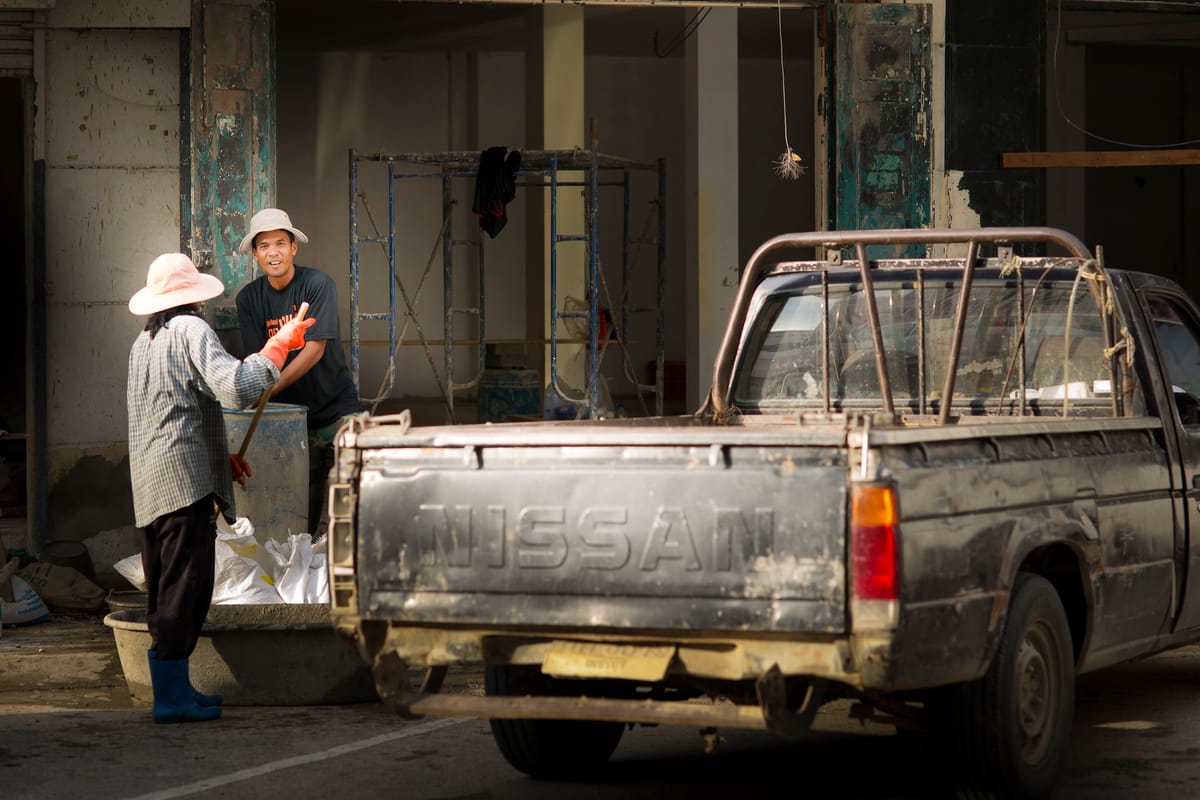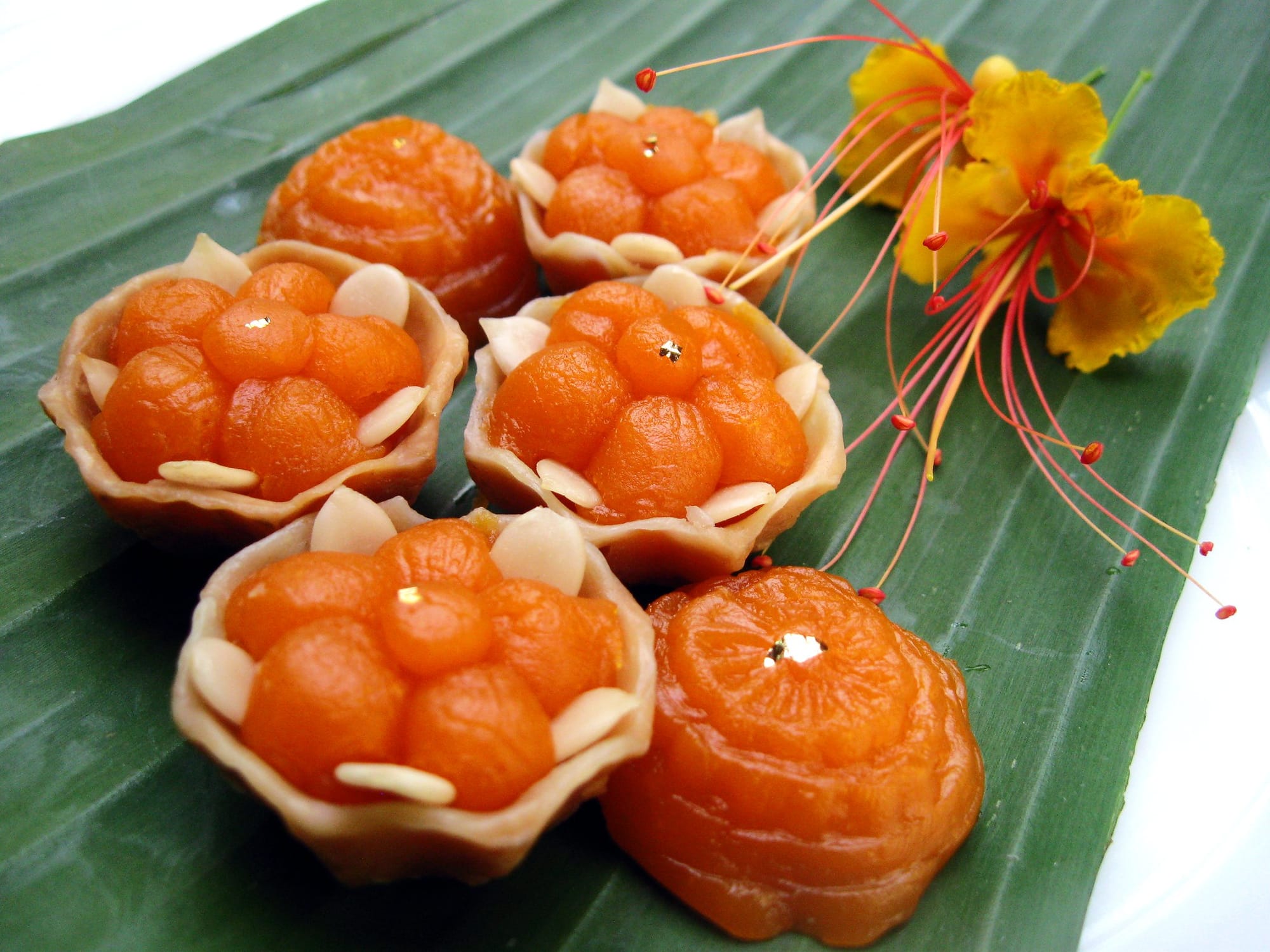Ja Mongkut

When I was young, going to the beach meant gorging on sweets.
The drive south from Bangkok to the seaside town of Huahin took more than a couple of hours, and Phetchaburi, a small city that has established itself as a destination for traditional Thai sweets and snacks, lay at the perfect distance at which a car-bound family needed to find a clean enough bathroom. You could stop at any of the roadside stands or storefronts to stretch, replenish, and look over table after table of pineapple-filled cookies and pandan-scented rice cakes. City people filled their arms with tall stacks of kanom mor kaeng, a coconut-and-palm-sugar custard steamed in metal trays that is the pride of the region.
My favorite of all the sweets in Phetchaburi was ja mongkut. It’s barely the size of a bottle cap, golden yellow in color and shaped like a small crown (mongkut). A fleck of real gold leaf topped its apex and a ring of hulled melon seeds formed its base. Ja mongkut is in the family of Thai desserts made of sweetened egg yolk. They’re related to Portugal’s fios de ovos, the recipe of which was likely brought over from Portugual by traders hundreds of years ago, first to the royal court and then beyond palace grounds. Phetchaburi’s dessert tradition followed that route after a royal palace was constructed nearby in 1860.
I favored not just any specimen of ja mongkut in Phetchaburi, but the kind sold by one particular vendor. If I walked to the back of the store, I could see an ancient woman seated on a wooden platform sculpting yellow balls of sweetened paste by hand. Hers was unlike any other ja mongkut. The crowns were tiny, but the construction of each was perfectly proportioned and consistent. It was more deeply scented than any other I had tried. To inhale while eating one felt like you were breathing through a bouquet of jasmine flowers. Most of all, her ja mongkut had a velvety texture that let it fold in your mouth before coming apart. It was never chewy or coarse. None of the other vendors came close, if they even had it.
I didn’t appreciate, at the time, how hard it is to make ja mongkut. In the old-school method, egg yolk is mixed with sugar and coconut milk, and then painstakingly reduced to a delicate paste over three hours in a copper pot, with constant stirring while maintaining the lowest of heat. Melon seeds are stirred by hands dabbed in jasmine syrup for a few hours over the same low heat, until sugars form thin, feathered frost over their surface. To make the syrup requires soaking fresh jasmine flowers in water overnight. The wafer pastry for the base should be thin enough to nearly see through, and the gold leaf must to be made from the purest gold, so as to avoid contaminant metals. It’s easy to see why of all the confections in the traditional “Nine Desserts of Prosperity” arrangement at important Thai ceremonies, ja mongkut earns its place on top.
Over many southward holiday trips I enjoyed the old woman’s ja mongkut. I ate them in the car and on the beach. Coming up the same route on our return to Bangkok, I would refill to make sure I had enough for a few more days.
Then one pit stop during a summer break from the U.S., I knew at first bite that the old woman was gone.
The store still sold trays of ja mongkut, but they were not much different from competitors’ versions. I faced the fact that this could be how it was, forever. I was enraged at the woman for not having made continuity plans. Could you not have taught what you knew to sons or daughters? Do you not think of us, starved city-dwelling types with fading childhoods?
I recognized, then, the mortality of foods.
According to National Geographic’s Enduring Voices project, every 14 days a language dies, with half of the world’s living languages estimated to disappear by 2100. The International Union for the Conservation of Nature estimates that hundreds, if not thousands, of species are lost every year for every million species on Earth. It is probable that the loss of foods or treasured recipes would exceed those numbers. It likely happens at scales large and small, and nearly everywhere. A baking enterprise goes bankrupt in the U.S.; a gas-station staple like Twinkies is threatened with extinction. There is a market for American candies that are no longer produced, with candy-seekers hunting down the last existing boxes the way others seek treasures on ocean floors.
In Thailand, an old woman passes, and so goes the way she has made sweets all her life. Especially in a place like Phetchaburi; once a sleepy city with a two-lane highway running through it, economic growth has brought in sweeping changes. What were once roadside stands and small storefronts are now huge confectionery industrial complexes with dozens of tour buses arriving on the hour for the requisite shopping stop. There’s more ja mongkut than ever—most stores now sell their own version—but these are lumpy specimens that look like they’re stamped out of a mold, and with today’s prices, the dot of gold leaf is often nowhere to be found. You can identify them as ja mongkut should you have a taste, but their fragrance underwhelms. The melon seeds look as if they are just stabbed into the golden flesh. A ja mongkut circa 2050 might exist as foamy protein suspension to be eaten out of a tube. Should I still be around, my Proustian moment would no longer be possible.
What would tomorrow’s children think should they come across a photo of ja mongkut? Would they recognize what it was? Would they know how it tasted?
I once stood in a hallway of the British Museum, nose pressed against the glass to look at a leg of duck, pieces of bread, and a few fruits—now no different from stone over the course of 3,000 years.
About 100 kilometers north of Phetchaburi, there’s a Thai Dessert Museum with plasticine models of various sweets and snacks displayed in glass cases. There I saw a model of ja mongkut awaiting its duty of remembrance.

Ja Mongkut Recipe
No written recipe with adequate details was found, but intrepid dessert-makers can watch these Thai-language videos of its preparation. Good luck.
How to make ja mongkut:
How to make the sugary yolk paste for the crown (relevant until 10:13):
